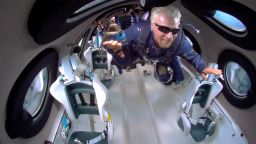Editor’s Note: Don Lincoln is a senior scientist at the Fermi National Accelerator Laboratory. He is the author of several science books for general audiences, including the best-selling audio book “The Theory of Everything: The Quest to Explain All Reality.” He also produces a series of science education videos. Follow him on Facebook. The opinions expressed in this commentary are his own. View more opinion articles on CNN.
Weather and technical conditions permitting, a spacecraft will Tuesday be launched vertically from a location southeast of El Paso. It’s expected to reach an altitude of 66 miles (106 km), leaving no doubt that it crossed the boundary between the sky and outer space – assuming everything goes well, of course. This launch will be particularly interesting for one reason: Jeff Bezos, the enormously wealthy founder of Amazon, as well as his own space company, Blue Origin, will be on board.

Bezos is not the first billionaire to make such a trip of course. On July 1, a spacecraft called VSS Unity carried Sir Richard Branson, billionaire and founder of Virgin Galactic, the company that made the space capsule, into space. (Technically there is some dispute about whether Branson reached space. The accepted international boundary of space is called the Kármán line, and it is an altitude of 100 km or about 62 miles. However, America defines the demarcation altitude as 80 km, or about 50 miles Branson reached 85km, approximately 53 miles.
Why do we care so much about billionaires taking trips to space? After all, people have been heading to space for 60 years, since Yuri Gagarin took the first trip. Unlike Branson and soon-to be-Bezos, he actually orbited the Earth for nearly two hours at a maximum altitude of 203 miles (327 km). And, of course, the past 60 years has had many successful manned missions into space, performed by countries including the US, the Soviet Union (now Russia), and China.
The interest comes from the fact that what we might call commercial space exploration, or “space tourism,” seems to be coming of age. What was once reserved for the very few is now like a Disney park ride for the super-rich.
Branson’s space company plans to eventually launch about 400 space flights per year, with a price tag for each individual’s ticket being upward of $250,000. Blue Origin’s business plan has not been released publicly, but early reports suggested that it will also charge in the ballpark of $200,000 for its suborbital flights. Blue Origin also has a plan for lunar flights and other options, but it is taking a slow but sure approach.
Then, of course, there is Elon Musk, who has not announced any plans to be a passenger in his own spacecraft, but has reportedly put down a deposit for a future Virgin Galactic trip. Musk is also a billionaire, who got his start at a company that ultimately became PayPal. He has since invested in or been a leader in many industries, including with the car company Tesla, growing his fortune. In 2002, he formed the company SpaceX, an aeronautical company with an ambitious program designed for commercial space flight.
SpaceX is far ahead of both Virgin Galactic and Blue Origin in terms of orbital flight. The company has received contracts from NASA to resupply the International Space Station since 2012 and has brought crews to the station, since 2020.
Of course, this raises the question: What is the value of the commercialization of space flight, including such ambitious projects as the establishment of a manned base on the Moon or Mars? Personally, I have publicly questioned the viability of such missions at a reasonable cost. While nobody can dispute how such grand goals can enthrall the public, a manned mission to Mars is prohibitively expensive, and I don’t ever see Mars being colonized. If we want to find places for people to live, we could “colonize” remote areas of Canada and Siberia far less expensively.
But for other tasks, commercial space flight is very attractive. NASA is developing a heavy lift vehicle called the Space Launch System, which NASA Administrator Jim Bridenstine guessed each launch will cost $800 million per rocket for a bulk order and $1.6 billion if NASA purchases just one. In contrast, SpaceX’s heavy lift vehicle called Starship is much cheaper. Musk has quoted a price of as little as $2 million per launch, although David Todd, an analyst at Seradata estimates a somewhat pricier cost of $10 million.
Either way, the much-reduced cost of using SpaceX to launch objects into space is obviously attractive. It means that scientists can spend more on the scientific instrumentation in their satellites. And, as a scientist who is enthralled by what NASA has done over the years, I can’t help but notice that a reduced launch cost could lead to many more interesting science missions.
It would take some engineering to have Musk’s newest rocket called “Starship” launch astronomical observatories like the Hubble Space Telescope or the James Webb Space Telescope, but it’s certainly possible that it could launch either. The Hubble is the world’s flagship astronomical observatory, and the Webb is its nominal replacement.
But Starship is a very powerful launch vehicle, outstripping the thrust of Saturn 5 rockets that sent men to the Moon. Starship can lift over 100 metric tons to low Earth orbit (LEO). In contrast, the Space Shuttle (which carried the Hubble telescope aloft) could lift only 29 metric tons to the same orbit. SpaceX clearly has the capability to lift satellites and telescopes into space.
And SpaceX’s earlier platform, called the Falcon 9 has already proven itself. For instance, the Transit Exploration Survey Satellite, a mission looking for planets around other stars was launched using the SpaceX Falcon rocket, as was the Jason-3 satellite, which is a climate-monitoring orbital platform. And there are plans in 2022 to use SpaceX rocketry to launch the Psyche mission – a probe to study a metallic asteroid. All of these launches would have been more expensive using NASA rocketry.
The real bottom line is that the commercialization of space will reduce launch costs and that has benefits for anyone needing to lift an object above the Earth’s atmosphere. My interest is in launching satellites carrying telescopes that can survey the cosmos and those that can monitor the wellbeing of our planet. I’m not as interested in the Disney rides on steroids – perhaps because I will never be able to afford such a trip – but if those launches generate income for the companies to devise better and more economical rockets, I’m all for it.
It’s obvious that commercial space flight has advantages for a vast range of customers and the three existing companies will compete to generate revenue. That helps all of us, perhaps by one company being more efficient than the others. And it’s always possible that another company may take up the torch and win the commercial space race.
Let the competition begin.




